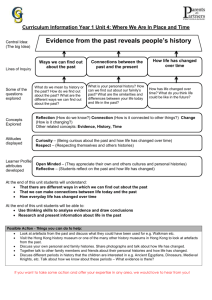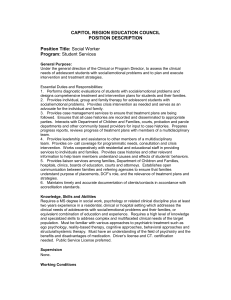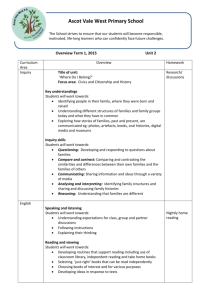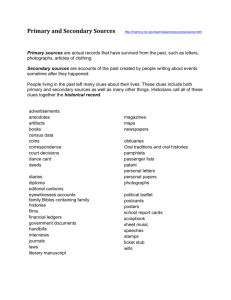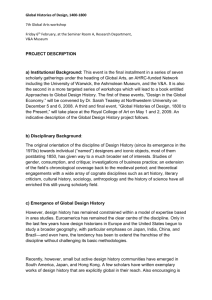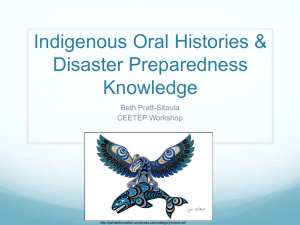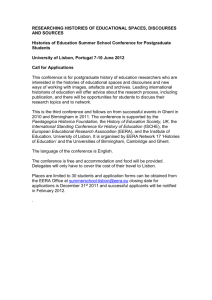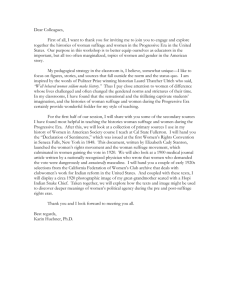File - Surveillance and the City
advertisement
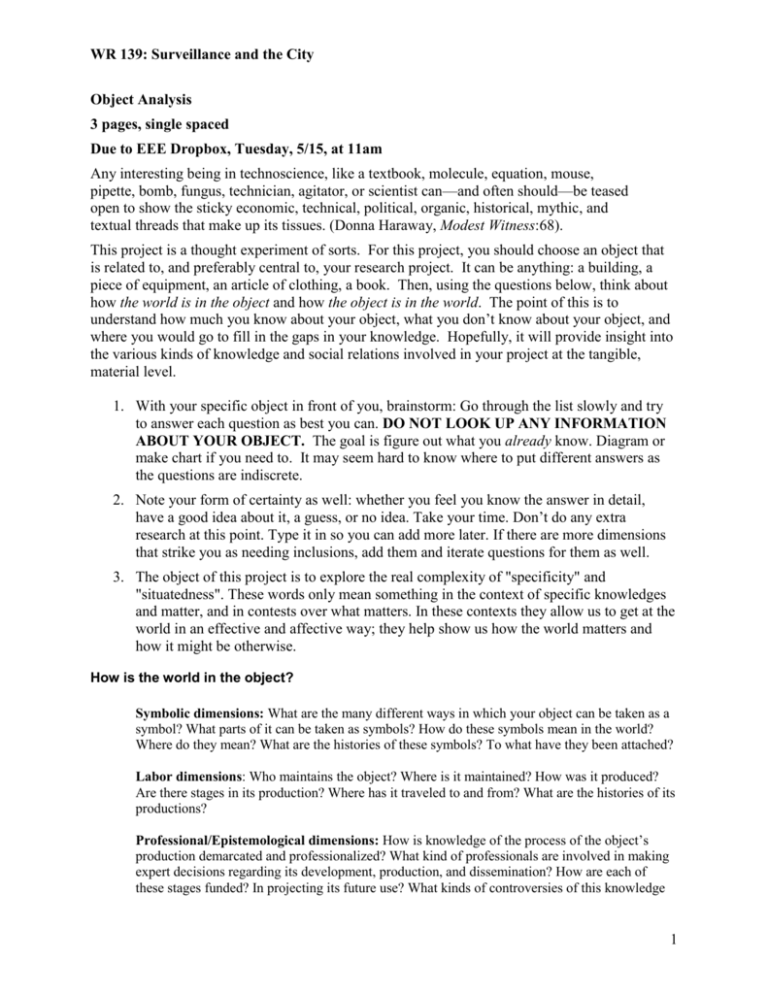
WR 139: Surveillance and the City Object Analysis 3 pages, single spaced Due to EEE Dropbox, Tuesday, 5/15, at 11am Any interesting being in technoscience, like a textbook, molecule, equation, mouse, pipette, bomb, fungus, technician, agitator, or scientist can—and often should—be teased open to show the sticky economic, technical, political, organic, historical, mythic, and textual threads that make up its tissues. (Donna Haraway, Modest Witness:68). This project is a thought experiment of sorts. For this project, you should choose an object that is related to, and preferably central to, your research project. It can be anything: a building, a piece of equipment, an article of clothing, a book. Then, using the questions below, think about how the world is in the object and how the object is in the world. The point of this is to understand how much you know about your object, what you don’t know about your object, and where you would go to fill in the gaps in your knowledge. Hopefully, it will provide insight into the various kinds of knowledge and social relations involved in your project at the tangible, material level. 1. With your specific object in front of you, brainstorm: Go through the list slowly and try to answer each question as best you can. DO NOT LOOK UP ANY INFORMATION ABOUT YOUR OBJECT. The goal is figure out what you already know. Diagram or make chart if you need to. It may seem hard to know where to put different answers as the questions are indiscrete. 2. Note your form of certainty as well: whether you feel you know the answer in detail, have a good idea about it, a guess, or no idea. Take your time. Don’t do any extra research at this point. Type it in so you can add more later. If there are more dimensions that strike you as needing inclusions, add them and iterate questions for them as well. 3. The object of this project is to explore the real complexity of "specificity" and "situatedness". These words only mean something in the context of specific knowledges and matter, and in contests over what matters. In these contexts they allow us to get at the world in an effective and affective way; they help show us how the world matters and how it might be otherwise. How is the world in the object? Symbolic dimensions: What are the many different ways in which your object can be taken as a symbol? What parts of it can be taken as symbols? How do these symbols mean in the world? Where do they mean? What are the histories of these symbols? To what have they been attached? Labor dimensions: Who maintains the object? Where is it maintained? How was it produced? Are there stages in its production? Where has it traveled to and from? What are the histories of its productions? Professional/Epistemological dimensions: How is knowledge of the process of the object’s production demarcated and professionalized? What kind of professionals are involved in making expert decisions regarding its development, production, and dissemination? How are each of these stages funded? In projecting its future use? What kinds of controversies of this knowledge 1 WR 139: Surveillance and the City are happening? Who is involved? In what kinds of institutions do they work? What are the political-economic histories of this? Material dimensions: What materials are involved in the object’s production and maintenance? Where have these materials come from? What are the labor dimensions of their production? What are the global, economic, and political dimensions of their use? What are the histories of these materials? How do these help constitute it? Technological dimensions: What kinds of technologies and machines enable the object to be produced and maintained? What kinds enable these other dimensions to be sustained? What sorts of information technologies are involved? What are the political, economic, bodily, labor and historical dimensions of these technologies? How do they help constitute it? Political dimensions: What sorts of politics are these dimensions involved in? What kinds of local, national and international bodies claim jurisdiction over it? In approving it (e.g. lobbyists, patents, corporate sponsorship, etc.)? What are the histories of regulations concerning it? How do these regulations help constitute it? Economic dimensions: How is the object involved in a world marketplace? What kinds of capital, debt, credit, and labor relations are involved in producing, marketing, and circulating it? What is the history of those relations? Who is involved at each stage and how are differences in power situated? How do these help constitute it? Textual dimensions: What texts are involved in the production of the object? What texts refer to this process? What kinds of texts? Who produces them and who reads them? Where and in what institutions? What are the histories of these texts? What kinds of textual associations can be made? Bodily/organic dimensions: How are bodies related to the object? Are there particular ways in which we think of ourselves that also involve or sustain this process? What kinds of bodies and bodily relations are involved in producing it? How are these bodies and relations gendered? Are there racial markings or other group identifications which help construct these bodies? What are the histories of all of these relations? How do these help constitute it? Historical dimensions: What concepts refer to the object? What are the histories of these concepts? Was it invented, when and by whom? Are there different and competing versions of its histories? Who tells these histories? How has it traveled historically? Repeat the above dimensions for each aspect of its history. How do these help constitute it? Particle Dimensions: How can the object be divided up? What are the parts of it? What are the stages of it? Treating each part or stage as an process, repeat the above analysis... How is “the object” in the world? Context and situatedness: Where does the object appear in the world? How does it appear and next to what or in what? What activities or ways of life enable one to come across it? What kinds of audiences is it addressed to? Who is excluded in these addresses? When can it appear? What is the rhythm of its appearance? How does this matter? 2 WR 139: Surveillance and the City Educational dimensions: How does the object appear in our socialization? When do we learn about it in school? In the rest of life? What kinds of people/bodies get to learn about it? How much do we learn about it? What aspects of it are avoided? What are the histories of teaching about it? How does this matter? Political dimensions: How is the object understood in terms of political positions in the world? How can we articulate the ways it is understood with political discourses? How is it hegemonic: in what ways can we see it as marshaling our consent to dominant orders? What kinds of legislation affect it? How do political considerations make use of it? What are the political positions as seen through the lens of this artifact: they often vary by artifact and moment)? How does this matter? Mythological dimensions: What roles does the object play in fantasies? What kinds of national narratives make use of it? How does it appear in entertainment? What other grand narratives, stories and strong associations involve it: e.g. progress, risk, joy, fear, science, militarism, success, decline, horror, self-improvement, financial security, nuclear family, motherhood, fatherhood, independence, adolescence, democracy, origin stories, stories of difference, privilege, death, pornography, sports...? How do these matter? Symbolic dimensions: How does this object serve in symbolic systems? What kinds of metaphors is it involved in? What sorts of ideas, metaphors, movements, ideologies, etc., are associated with it? For whom are these relevant , to whom do they matter, what contests over meaning are they involved in? What are the histories of these meanings and contests over meaning? How do they matter? Labor dimensions: How is the object used? What forms of labor and work is it associated with? What forms of labor and work incorporate it or make use of it? Is it used up? If not, how is it passed on, transferred, communicated? What routes do these processes take? What kinds of actors (human and non-human) are involved and what kinds are excluded? Professional/epistemological dimensions: What kinds of knowledge count in talking about the object? How does emotional attention fit in? What forms does knowledge about it take (e.g. journalism, academic papers, commonsense, tabloids, computers, etc.)? What facts can we tell about it? What discourses of authority claim competence over them? How is it articulated by medical , legal, governmental, religious, psychological, engineering, military, economic, academic, new age, and educational professionals? Material dimensions: How do the materials of the object appear? How are they disposed of? What hazards are considered among these materials? What are the historical, scientific, and political dimensions of these materials? Technological dimensions: What technologies are joined with the object? What sorts of machines does it work with? What kinds of machines are articulated to it? Who has access to these machines and technologies? What are the histories of them? Economic dimensions: The process as commodity: how is it marketed, purchased, consumed? Where and by whom? What are the economic statuses and positions of those who are associated with it? Who sells it? How are costs calculated? How are risks calculated? By whom and when? How do these matter? 3 WR 139: Surveillance and the City Textual dimensions: What texts refer to the object? What kinds of textual associations are involved? Who produces and who reads these texts? What kinds of institutions are involved in these processes? What are the histories of these processes and institutions? How are these texts funded? How does this matter? Bodily/organic dimensions: What kinds of bodies and bodily relations make use of the object? How are these bodies gendered, racialized and differently abled? What kinds of ways of life are involved? How do these matter? Twist 1: Brainstorm Knowledge Map When you are done, you have a map of your knowledge on the subject, of your common sense as well, of what you have felt worth knowing, and of what you have learned to attend to in your life, everyday and academically. The brainstorm is thus really a braindump. The braindump is also a story dump. Getting all of the stories you have learned to tell about the subject, with all of their plots and forms and tropes out in the open. Hopefully at some point you ran out on certain questions and really started thinking about connections in new ways. The methodological implications of this for ethnography: This is not just meant to be a reflective exercise. When one conducts ethnographic interviews and oral histories, people usually have at least one to three hours of canned stories – honed, carefully put-together stories – that are fascinating and designed to be so. This is understandable and necessary as people have to explain themselves to others repeatedly and stories are mnemonic condensation devices for meanings and facts, and represent the experience of badly told tales and misunderstandings. But after that initial 1-3 hours, if one keeps asking questions about specific connections, people, and events, there is a vast land of forgotten memories, tentative and alternative explanations, and new understandings and formulations of meanings. The implosions exercise, in part, is meant to materialize that in your own stories / relationships to your object. 4
